Introduction
Line dancing is a type of partnerless dance in which people dance in single-file lines or rows without regard for the gender of the individuals, all facing the same direction and executing the same moves at the same time. It is a great form of exercise, allowing you to have fun while getting moving. Learning to line dance can be easy and enjoyable if you have the right attitude and know the basics.
Breakdown of Basic Steps
The first step in learning to line dance is to understand the different types of steps used in line dancing. These include walking steps, heel/toe steps, shuffles, and kicks. Each step has a specific pattern that must be followed in order to be performed correctly. For example, the heel/toe step is executed by stepping forward on your heel, then bringing your toe up to meet it, and then repeating this motion. Once you have mastered the basic steps, you can move on to more complex moves such as turns, spins, and slides.

Counting Beats and Music Tempo
Another important skill for line dancing is understanding how to count beats and music tempo. This is essential in order to ensure that you are performing the steps correctly and in sync with the rest of the dancers. In order to become proficient at this, you should practice counting out loud with a metronome or other device that measures the tempo of the music. This will help you to learn the timing of each step and how to stay in rhythm with the rest of the dancers.
Easy-to-Follow Line Dances for Beginners
Once you have mastered the basics of line dancing, there are many easy-to-follow line dances for beginners. Popular dances include the Electric Slide, the Cha Cha Slide, the Cupid Shuffle, and the Boot Scootin’ Boogie. To learn these dances, you can watch instructional videos online or attend a local class. Most instructors will demonstrate each dance step-by-step so that everyone can follow along easily.

Tips for Practicing at Home
If you want to practice line dancing at home, you should first find some practice music and videos to use. This will help you to familiarize yourself with the steps and count beats. You should also set up a practice space where you can move freely and not worry about bumping into furniture or tripping over rugs. A good practice space should be free from distractions and have plenty of room for you to move around.
Benefits of Learning Line Dancing
Aside from being a lot of fun, learning to line dance can also offer many physical and mental benefits. Line dancing can improve coordination and balance, as well as increase self-confidence. It is also a great way to socialize and make new friends. As you progress, you can learn more complicated dances and even join local line dancing classes.
Group Etiquette
When learning to line dance in a group setting, it is important to remember to respect other dancers and follow directions from the leader. Always listen carefully to the instructions given and try to stay in step with the rest of the dancers. It is also important to take breaks when needed and practice safe dance movements.

The Fun of Line Dancing with Friends
Line dancing is a great way to get active and have fun with friends. Joining a local line dancing class is a great way to meet new people and learn new dances. Even if you don’t know anyone else in the class, you can still have a great time and make new friends. There is nothing quite like the feeling of dancing in unison with a group of people and having a great time.
Conclusion
Learning to line dance can be a great way to get fit, make friends, and have fun. It is important to understand the basic steps, count beats, and practice safely in order to get the most out of it. With practice and dedication, you can reap the many benefits of line dancing. So why not give it a try and see what it can do for you?
(Note: Is this article not meeting your expectations? Do you have knowledge or insights to share? Unlock new opportunities and expand your reach by joining our authors team. Click Registration to join us and share your expertise with our readers.)
